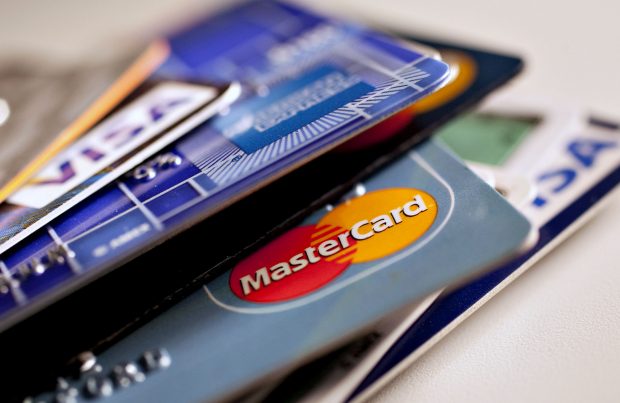 American Express, MasterCard and Visa credit cards are displayed for a photograph. Photographer: Daniel Acker/Bloomberg
American Express, MasterCard and Visa credit cards are displayed for a photograph. Photographer: Daniel Acker/Bloomberg
Credit unions increased their share of the credit card market in September, while holding steady in automotive lending, according to a Fed report released Thursday.
The Fed's G-19 Consumer Credit Report showed credit unions held $64.4 billion in credit card debt on Sept. 30, up 6.9% from a year earlier. Credit unions' share was 6.2% in September, about the same as August and up from 6% in September 2018.
Recommended For You
The Fed also showed all lenders held $1.19 trillion in car loans in September, up 4.3% from a year earlier. CUNA estimates released Tuesday show credit unions held $382.9 billion in automobile loans in September, up 4.1% from September 2018, the slowest 12-month gain in years.
Based on the numbers from the Fed and CUNA, credit unions held 32.1% of automotive loans in September, the same as year earlier. The Fed uses CUNA estimates in its G-19 calculations.
Better results for credit unions were in the credit card market, where credit union balances grew nearly twice as fast as other lenders. However growth rates were slower than a year ago for both banks and credit unions.
Lenders of all types held $1.04 trillion in credit card debt as of Sept. 30, up 3.6% from a year earlier.
Banks held $932.9 billion in credit card debt, up 3.6% from a year earlier. Banks' share was 89.7% in September, unchanged from August and September 2018.
The 10 largest credit unions for credit card balances for the third quarter won't be available for another month, but among the credit unions in the 2nd quarter's Top 10 for that category, they held $26.4 billion in credit cards as of Sept. 30, up 12.5% from a year earlier, while their total loans rose 8.1% to $182.6 billion.
These large credit card holders collectively had $259.9 billion in assets among 19.4 million members as of Sept. 30. Here's how they did:
- Navy Federal Credit Union, Vienna, Va. ($110.1 billion in assets, 8.9 million members) had credit cards at $18.8 billion, up 15.8%, while total loans ended the quarter at $78.8 billion, up 10.1%.
- PenFed, Tysons, Va. ($24.8 billion in assets, 1.8 million members) had credit cards at $1.7 billion, down 0.1%, while total loans ended the quarter at $19.8 billion, down 1.4%.
- BECU, Seattle ($21.8 billion in assets, 1.2 million members) had credit cards at $1.2 billion, up 8.7%, while total loans ended the quarter at $13.9 billion, up 10.3%.
- State Employees' Credit Union, Raleigh, N.C. ($40.9 billion in assets, 2.5 million members) had credit cards at $782.3 million, up 2.1%, while total loans ended the quarter at $24 billion, up 6.4%.
- SchoolsFirst Federal Credit Union, Santa Ana, Calif. ($16.1 billion in assets, 920,031 members) had credit cards at $766.9 million, up 2.5%, while total loans ended the quarter at $9.7 billion, up 14.6%.
- Pennsylvania State Employees Credit Union, Harrisburg ($5.6 billion in assets, 466,524 members) had credit cards at $753.7 million, up 2.7%, while total loans ended the quarter at $4.5 billion, up 8%.
- Suncoast Credit Union, Tampa, Fla. ($10.4 billion in assets, 861,191 members) had credit cards at $747.3 million, up 13.6%, while total loans ended the quarter at $8 billion, up 12.9%.
- America First Federal Credit Union, Riverdale, Utah ($11.5 billion in assets, 1.1 million members) had credit cards at $580.6 million, up 10.5%, while total loans ended the quarter at $9 billion, up 9.5%.
- Randolph-Brooks Federal Credit Union, San Antonio ($9.6 billion in assets, 860,157 members) had credit cards at $526.6 million, up 10.5%, while total loans ended the quarter at $7.2 billion, up 0.3%.
- Mountain America Federal Credit Union, Salt Lake City ($9.1 billion in assets, 859,509 members) had credit cards at $491.6 million, up 7.2%, while total loans ended the quarter at $7.7 billion, up 10.7%.
However, the Fed report showed credit card growth is slowing. The 12-month gain was 8.4% for credit unions and 7.6% for banks a year ago.
And Thursday's report also showed weaker results from August to September.
Credit card balances among credit unions rose 0.2% from August to September compared with a 0.8% gain a year earlier. Balances among banks fell 0.5% from August to September, compared with a 0.2% drop a year earlier.
© 2025 ALM Global, LLC, All Rights Reserved. Request academic re-use from www.copyright.com. All other uses, submit a request to [email protected]. For more information visit Asset & Logo Licensing.








